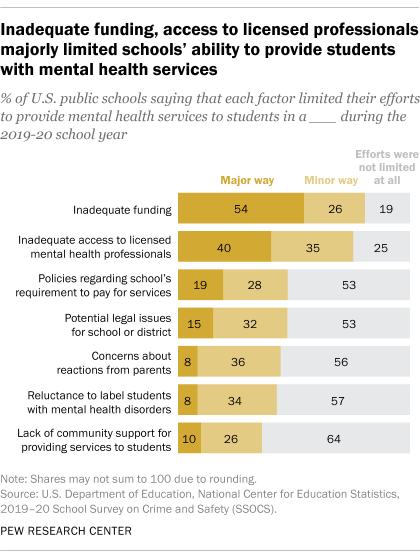Citing an “unprecedented mental health crisis” among young people in the United States, the Biden administration recently announced new funding to expand mental health services in the nation’s K-12 schools. While school-based mental health services have become more common in recent years, many K-12 schools lack such resources, according to the most recent available government data.
Overall, just over half of U.S. public schools (55%) provided students with diagnostic mental health assessments to evaluate them for mental health disorders during the 2019-20 school year, according to the National Center for Education Statistics’ (NCES) School Survey on Crime and Safety. These assessments were conducted by a licensed mental health professional employed or contracted by the schools.
Among public schools that made mental health assessments available for students, 61% provided them both at school and outside of school, and 29% offered them at school only. Just 11% provided them only outside of school.
Fewer public schools provided treatment to students for mental health disorders. In the 2019-20 school year, 42% of K-12 schools offered mental health treatment to lessen or eliminate symptoms, such as psychotherapy, medication or counseling through a licensed mental health professional. Most schools that offered this type of treatment (62%) provided it both at school and outside of school. Three-in-ten provided treatment at school only, and just 7% provided it only outside of school.
The proportion of public schools that have mental health services for students has ticked up somewhat since the 2017-18 school year, when 51% of schools provided mental health assessments and 38% offered treatment.
Whether mental health services were offered in the 2019-20 school year and what they looked like varied based on a variety of school characteristics:
- In 2019-20, middle and high schools were more likely than elementary schools to provide school-based mental health services. Roughly two-thirds of middle (64%) and high schools (65%) offered mental health assessments, while half of elementary schools did so. And 47% of both middle and high schools provided treatment, compared with 40% of elementary schools.
- Mental health services were more common in schools with larger enrollment numbers. For instance, 71% of schools with at least 1,000 students offered mental health assessments, compared with 43% of those with fewer than 300 students.
- Around six-in-ten schools in cities (61%) and suburbs (60%) provided mental health assessments, while 45% of those in rural areas did. City schools were also somewhat more likely to offer treatment: 45% offered it, compared with 40% of suburban schools and 41% of rural ones.
- There were also some differences based on the racial and ethnic makeup of the student body. Six-in-ten schools where over 75% of students were racial or ethnic minorities provided assessments for mental health disorders in the 2019-20 school year, compared with half of schools where a quarter or fewer of students were racial or ethnic minorities.
- Schools with greater shares of students from lower-income households were somewhat more likely than other schools to provide student mental health treatment. One proxy measure of household income level is the share of students who qualify for free or reduced-price lunch. Just under half of schools (46%) where more than three-quarters of students were eligible for this program had mental health treatment available in 2019-20, compared with 39% of schools where a quarter or fewer qualified for free or reduced-price lunch.
- where more than three-quarters of students were eligible for this program had mental health treatment available in 2019-20, compared with 39% of schools where a quarter or fewer qualified for free or reduced-price lunch.
Limiting factors

The School Survey on Crime and Safety also asked schools to what extent several factors limited their efforts to provide student mental health services. The largest shares of schools reported that their efforts were limited in a major way by inadequate funding (54%) or inadequate access to licensed mental health professionals (40%). Another 26% reported that funding limited their efforts in a minor way, while 35% said access to mental health professionals was a minor limiting factor. About one-in-five schools (19%) said that funding did not limit their efforts at all, and a quarter said the same about access to professionals.
Smaller shares of schools said that their efforts were limited in a major way by written or unwritten policies regarding the school’s requirement to pay for the diagnostic mental health assessment or treatment of students (19%); potential legal issues for the school or district, such as malpractice, insufficient supervision or confidentiality (15%); a lack of community support for providing mental health services to students in their school (10%); concerns about reactions from parents (8%); or reluctance to label students with mental health disorders to avoid stigmatizing the child (8%).
About two-thirds of schools (64%) said that lack of community support did not limit their efforts at all – the largest share saying this about any factor included in the survey.
To continue to the article, CLICK HERE.
